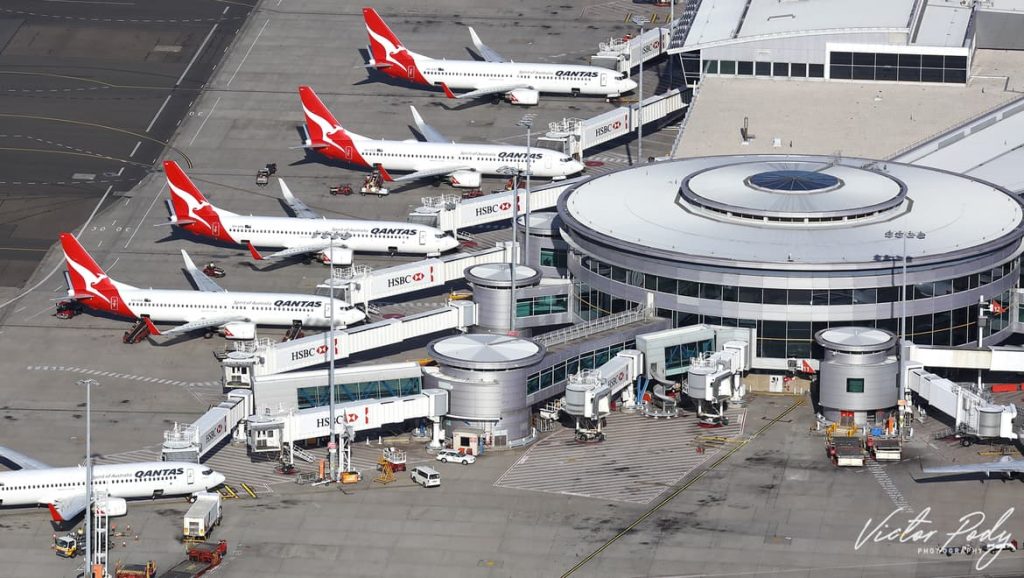
Chaos has again erupted at Sydney Airport on Monday after an electrical storm ripped through Mascot, causing dozens of cancelled flights and many more delays.
The airport was forced to shut down to all arrivals and departures for at least an hour and a half on Monday morning, due to “lightning in the vicinity of the airport”, a Sydney Airport spokesperson told Australian Aviation.
According to a report by the Daily Telegraph, thousands of passengers were informed this morning that there would be no arrivals or departures from the airport until the “wild weather” subsides.
By 11:30am, “normal operations” had resumed, according to the airport spokesperson.
Sydney Airport locked down due to storms so just chilling in the lounge @Qantas ☕️??
— CrinDavey ?????? (@CorinnaWho) May 23, 2022
However, as of Monday afternoon, a total of 36 domestic flights from the airport has been cancelled, with many more significantly delayed.
Meanwhile, passengers took to social media to again report hours-long wait times in queues at the terminal, while airlines attempted to catch up flight schedules following the morning’s disruption.
Over in the international terminal, arriving passengers also reported hours-long lines, due to the airport’s digital passport scanners being out-of-action, sending hundreds of arriving passengers to the few staffed immigration booths.
Passengers also saw delays in recovering their checked baggage, seemingly due to a lack of available ground crew unloading bags from aircraft. Australian Aviation understands that these delays are due in part to Monday’s weather, as well as ongoing COVID-related staffing issues.
Go to Australia they said, it’s one of the richest countries they said.? @SydneyAirport in queue at arrival for 1hr and half now. ? pic.twitter.com/YmbPSW79Gf
— cindy (@szhindee) May 22, 2022
Two years on and @SydneyAirport clearly very badly organised and not ready. Walked out of Heathrow within 12 minutes last week, already queuing 45 minutes here…..
— Timo (@tbures) May 22, 2022
In case there was any question – absolute chaos at @SydneyAirport due to @Qantas still not hiring enough staff.
— AJ (@RockynCharlie) May 22, 2022
It comes ahead of the planned opening of Western Sydney Nancy-Bird Walton Airport, which will boast premium technology to allow aircraft to safely take-off and land in foggy conditions that currently “shuts down Sydney’s skies”. Western Sydney Airport is due to open in 2026.
It also comes after Australian Aviation last week reported that domestic flight delays in April were the worst since records began – with almost 40 per cent of arrivals and departures not on time.
The results were poor among all major airlines, though across the entire month, Qantas – Australia’s only premium airline – slipped behind its cheaper rivals with on-time arrivals slumping to just 59 per cent, compared to Rex’s 74 per cent and Virgin’s 66 per cent.
According to the Bureau of Infrastructure and Transport Research Economics (BITRE), the overall cancellation rate crept up to 4 per cent for the month, which saw both the Easter and Anzac Day long weekends.
“These are the worst on-time performance figures recorded since recording commenced in November 2003. This month’s figures were impacted by weather-related events, congestion (highest number of sectors flown since the commencement of COVID-19) and other COVID-19 related issues,” the BITRE release reads.
The delays during the holidays attracted huge national media attention, with airports around the country seeing enormous snaking lines at check-in, bag drop and security.
At the same time, Sydney Airport was forced to cancel dozens of flights in the days leading up to Easter.
The chaos saw passengers grow increasingly frustrated, due to missed and cancelled flights and additional stress after two years without the ability to travel.
Both Sydney Airport and Qantas blamed the extensive wait times, in part, on travellers themselves, however, many passengers said that there was a visible staffing issue that saw security lanes and check-in desks closed and non-operational.
As reports first emerged of holiday-induced chaos in Sydney, Qantas CEO Alan Joyce blamed delays on “not match fit” travellers.
“I went through the airports on Wednesday and people forget they need to take out their laptops, they have to take out their aerosols … so that is taking longer to get through the [security] queue,” he said.
He added COVID close-contact rules were causing “high level of absenteeism” of up to 18 per cent, however NSW Health later eased close contact rules for aviation workers, allowing them to return to work with a mask if they show no symptoms and test negative to COVID, even if someone in their household has tested positive.















